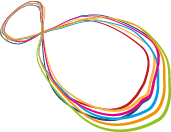Art & Culture
The works of artTonus, 1995
by Kazuo Katase
Installations at the University Hospital
Art in public space
Hoop: metal, color anodized (yellow) and stove-enameled (black) diameter 15 m, width 75 100 cm, depth 30 cm.Wedge: metal, rusted, 100 x 100 x 400 cm.Sphere: granite, diameter 100 cm.Hemisphere. Granite, diameter 100 cm, height 50 cm
Freiburg University Medical Center
between the Neurocenter and the Women's Clinic
Breisacherstraße
Strength lies in tranquillity
The largest sculpture in Freiburg, both in terms of height and surface area, is located at the Neurocenter of the University Hospital on Breisacher Strasse. On entering the site from here, the viewer is impressed by the work of art, which is as simple as it is monumental.
The concept for the work, entitled "Tonus", or tension, was created by the Japanese artist Kazuo Katase, who lives in Kassel and took part in the 1992 documenta. His work was the winner of a limited competition for art in architecture organized by the Freiburg Regional Finance Office¹.
The sculpture, erected in 1995, consists of three parts that relate to each other in terms of both form and symbolism.
The most striking and important part of the expansive environment is a 32-ton, yellow and black steel ring with a diameter of 15 meters, which stands upright on a slope. It includes a rusty wedge welded together from Corten steel plates, which appears to prevent the ring from rolling away. A sphere with an engraved star and a hemisphere, each one meter in diameter, both made of black, smoothly polished granite, complete the ensemble, which forms an imaginary triangle as seen from above.
The dominant element, the ring, initially alludes with its shape to the "Lorenzring", the ring-shaped grouping of all clinics designed by senior government building officer Adolf Lorenz in 1926, but which was not completed after the Second World War - new clinic buildings did not follow this plan.
Katase's ring also has philosophical and medical references in its complex symbolism. "The color yellow stands for energy and activity," explains Katase. "The color black stands for calm and relaxation. The light and dark of our lives must be in a dymanic relationship of tension."² With his black and yellow ring, Katase finds a form of expression that is reminiscent of the principle of yin and yang, which plays a major role in Far Eastern philosophy and medicine. Yin corresponds to the negative, feminine, dark and passive, while yang corresponds to the positive, masculine, light and active. Both forces must be kept in balance. If a disharmony arises, for example through illness, medicine must try to restore the lost balance. This is symbolized by the wedge, which keeps the ring in the necessary balance.
The granite sphere and its star on the forecourt of the Neurocenter are intended to symbolize the unity with the inner and outer world in which man finds himself, microcosm and macrocosm.
The black hemisphere, on the other hand, whose cut surface is conceived as a flat bowl that absorbs and releases water, is to be understood as a metaphor for the human ability to take and give. In terms of design, it takes up the forms of the ring, the sphere and the circular fountain, which is not actually part of Kazuo Katase's work.
At the suggestion of the University Building Authority, Katase was asked by the art commission of the Chief Finance Directorate after the completion of the "Tonus" group to submit a design for the extension of his concept for the square in front of the Medical Clinic, the intersection of two paths leading through the clinic grounds.
See also Voice from the Hill
The artist himself also emphasizes the meditative function of his artwork: "People should encounter the mountain in peace, observe it in order to hear their inner voice and feel its existence".5
Kai Fischle
| Kazuo Katese | born 1947 in Shizuoka / Japan. After initial successes with solo exhibitions in Japan, Kazuo Katase moved to Germany in 1975. He had an exhibition at the Städtische Galerie im Lenbachhaus in Munich in 1985, at the Centre National d'Art Contemporian de Grenoble in 1989 and at the New Museum of Contemporary Art in New York in 1991. In 1992, Katase took part in documenta 9 in Kassel. He has been associated with the city of Freiburg since his exhibition at the Adelhauser Kloster in 1988. The artist has lived and worked in Kassel since 1976. |
| Tonus (Kazuo Katase) |
|
| Literature |
|
Source: Michael Klant: Sculptures in Freiburg - 20th century art in public space
mondo Verlag GmbH Freiburg, 1st edition 1998, ISBN 3-922675-76-X.
University Medical Center Freiburg
Hugstetter Straße 55
79106 Freiburg
Phone: 0761 270-0
info@uniklinik-freiburg.de

